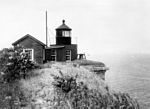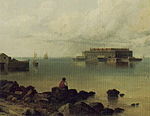The Narrows
Bodies of water of Staten IslandStraits of Kings County, New YorkStraits of Richmond County, New YorkUse American English from April 2019Use mdy dates from April 2019

The Narrows is the tidal strait separating the boroughs of Staten Island and Brooklyn in New York City, United States. It connects the Upper New York Bay and Lower New York Bay and forms the principal channel by which the Hudson River empties into the Atlantic Ocean. It has long been considered to be the maritime "gateway" to New York City and historically has been one of the most important entrances into the harbors of the Port of New York and New Jersey.
Excerpt from the Wikipedia article The Narrows (License: CC BY-SA 3.0, Authors, Images).Geographical coordinates (GPS)
| Latitude | Longitude |
|---|---|
| N 40.613333333333 ° | E -74.048055555556 ° |







